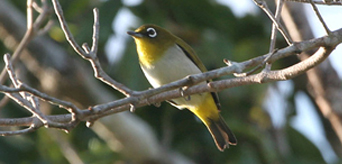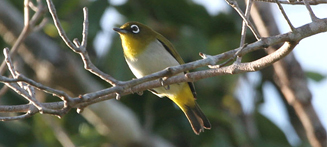Birding on Ambon
Summary:
The travel hub of central and southern Maluku. Got a few nice birds too.
Key bird species:
Moluccan Scrubfowl, Claret-breasted Fruit-dove, Moluccan Flycatcher, Spectacled Monarch, Ambon White-eye, Ashy Flowerpecker
Birdwatching locations:
Ambon is likely to be somewhere you pass through, rather than aim for, but when you find yourself here you are going to have to stop long enough to find the one endemic – Ambon White-eye – and it is also worth adding a morning to see Moluccan Scrubfowl on nearby Haruku Island.
The white-eye Basically simple; you find a patch of degraded forest anywhere on the island, and look! Regular options include remnant forest patches above Ambon City near the village of Soya (just get a minibus or motorbike taxi to Soya, then explore) and tracks heading inland behind Tulehu. This latter options stretches for miles, with the habitat steadily improving as you get higher up on the slopes of Gunung Salahatu. Other birds possible in these forest patches include Moluccan Flycatcher, Spectacled Monarch and Ashy Flowerpecker. Formerly quite a few of the Seram endemics were recorded on Ambon, including Purple-naped Lory, Lazuli Kingfishe, Rufous-necked Sparrowhawk and Seram Myzomela, but you dont hear of many recent records. For a chance of refinding some of these on Ambon the best bet would be to mount a mini-expedition towards the summit of Gunung Salahatu. Who knows what else is up there? Moluccan Scrubfowl Birds nest within a sandy area just to the south of the village of Kailolo on the small island of Haruku. Every night birds seem to approach the nest ground, dig holes and lay eggs. Every morning the people of Kailolo try and dig them all up, sell them, and eat them. Villagers confidently proclaim this is sustainable management, but all freely admit that birds are rarer now than they used to be… This said, it is still a pretty reliable place to see Moluccan Scrubfowl. If you are using a local guide in Ambon, ask them about arrangements. The usual tactics are either to go over in the late afternoon and wait until nightfall, or go very early in the morning and try before it gets light. If you wanted to head over on your own, you should really turn up during the day and ask first in the village for the site’s owner (it is owned by someone). He will then help you with some arrangements (at a cost). Please do not just enter the nesting area on your own without permission. You won’t make many friends this way, and you will make it harder for people that follow.Access and Accommodation:
Ambon is served by many flights, and many boats. The range of accommodation options, eating options and cultural attractions are all very well described in many travel guide books.
For those people heading to Seram, or wanting to visit Haruku, then staying in the Natsepa/Tulehu area is usually most convenient. For those getting boats to Buru or southern Maluku, then staying in Ambon City is probably most convenient. If you are just flying in and out, then there are several hotel options on that side of the bay. If you have not travelled to Ambon with a guide, and you are looking for one locally, try the contact details listed below.More info:
Scroll down the page for related information, including photos, comments, trip reports, guides and services, articles and news. . If you can update this account, or find things have changed, please add your comments below to make it easier for the next person. Thanks!
Site map:
To download the kml file click here



There’s also a megapode nesting site at Haruku village, south of Kailolo.
Here, Eliza Kyssa runs a small conservation project, funding most of it himself [not delighting his wife perhaps!]
Including for scrubfowl; earlier bought eggs from Kailolo to augment the small breeding population here.
Got problems, including beach being eroded, reducing area of sand for megapodes to nest in. A Burung Indonesia funded wall to protect a sand area was recently damaged in severe flood.
But, visiting Aug 2016, saw megapode arrive to dig nest at night, on sand area across a creek; one of six that night.
Eiza said birds sometimes linger after dawn, and saw one extremely close, getting photos.
Can be dugongs here, too, especially late in year when water clearer in dry season.
Eliza not so easy to reach by his phone; but he and his wife a great couple, v hospitable, and with a cabin w couple of beds where guests can stay, maybe enough beds for some “overflow”
So maybe worth considering; and perhaps money spent here is better for conservation benefits.
http://www.kewang-haruku.org/eliza.html